After reaching unthinkable heights in his first year, Juan Pablo Vojvoda ran out of ideas as his team failed to win their first eight league games of the season. With a dynamic and daring 3-4-1-2, Vojvoda took Fortaleza from barely avoiding relegation in 2020 to comfortably finishing amongst the top four in 2021. The Ceará-based club had never been one to challenge Brazil’s elite, rather notoriously going back and forth between the country’s first two divisions. After Rogério Ceni settled the Leão do Pici in the Série A, club president Marcelo Paz looked for a replacement capable of leading them to the next echelon of Brazilian football.
Juan Pablo Vojvoda took over Fortaleza in May 2021, just before the league started. With a few interesting projects in Argentina, Vojvoda was much more of a promise than a sure thing. There wasn’t much time for projecting though, as Fortaleza beat Atlético Mineiro and Internacional in the Argentinian’s first two league matches in charge. The 47-year-old manager led the Tricolor to a top-four finish and a historic Copa Libertadores qualification.
As a player, Vojvoda was a product of Newell’s Old Boys’ academy, where he was coached by none other than Marcelo Bielsa in his youth days. Bielsa, an influential manager with experience in the Premier League, La Liga, and Ligue 1, has been cited as a big influence on Vojvoda’s coaching philosophy. In addition to El Loco, Man City boss Pep Guardiola has also been another major inspiration as Vojvoda has developed his playing style. This mixture of influences can definitely be seen through the Argentinian’s tactics, as it incorporates key principles of multiple schools.
These tactics took Brazil by storm in his first year, however, in the second, Vojvoda’s Fortaleza became a victim of their system. With such a unique structure, accommodating each player’s characteristics, Fortaleza were unable to cope with changes in personnel. Additionally, after a year of success, many clubs were beginning to solve the puzzle that was this new-look Fortaleza. Fortaleza – and Vojvoda – stared into an uncertain future after a win-less start to the season.
With his back against the wall, the Fortaleza manager decided to transform and restructure his side. In this tactical analysis, we will examine how a change in structure revived Fortaleza in 2022. After the side looked destined to battle out of relegation, Juan Pablo Vojvoda was able to lead them to a comfortable mid-table finish. This analysis will explore how Fortaleza’s tactics have changed, and more specifically, the side’s new attacking and defensive systems.
Structures and players
At first, there was not much change in Fortaleza’s squad. When the Ceará-based club began the 2022 Série A, aside from some new young and promising faces, they had the same resources as in the past season. At any rate, they struggled to get results. Although they played well, they constantly failed to win games. Their defensive system was nowhere near as secure, and with the ball, they struggled to find efficiency. The lack of change or adaptations in the tactics saw them become predictable and ineffective.
In the 2021 Série A, Vojvoda used a 3-4-1-2 56% of the time. Although there were a few adaptations and variations, none of them were significant. Their structure was their identity, and their formation was responsible for how they played.
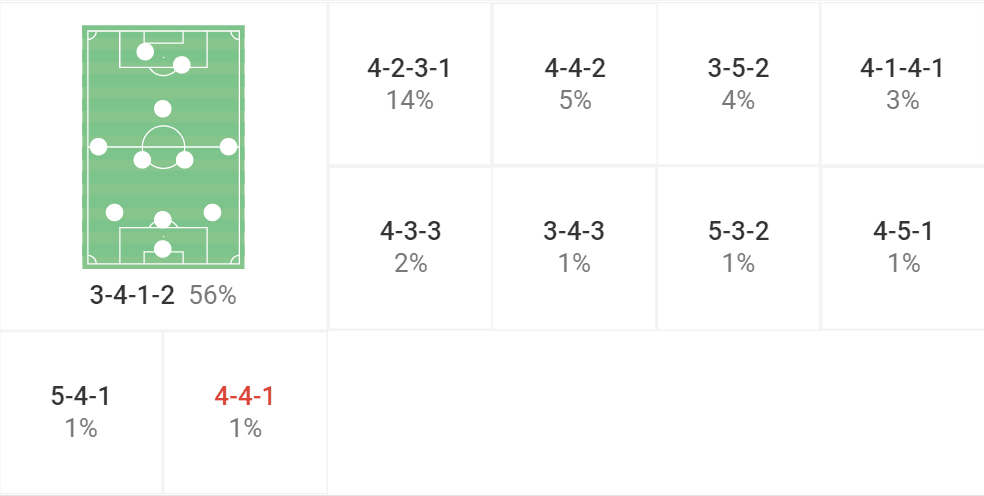
This 3-4-1-2 saw them become very wing-oriented. With the central centre-back and the attacking midfielder being the only players occupying the central lane, the double pivot and the centre-forward duo looked to support the wing-backs and wide centre-backs out wide. This can be seen in one of their pass maps below, as their focus in possession was concentrated on the wide areas.
This was a direct result of their players’ characteristics. On the right, Yago Pikachu and Tinga were able to create overloads and progress forward. On the left, with Lucas Crispim being an inverted wing-back, the left-sided centre-forward and left-sided centre-midfielder were able to drift wide and interchange roles in possession.
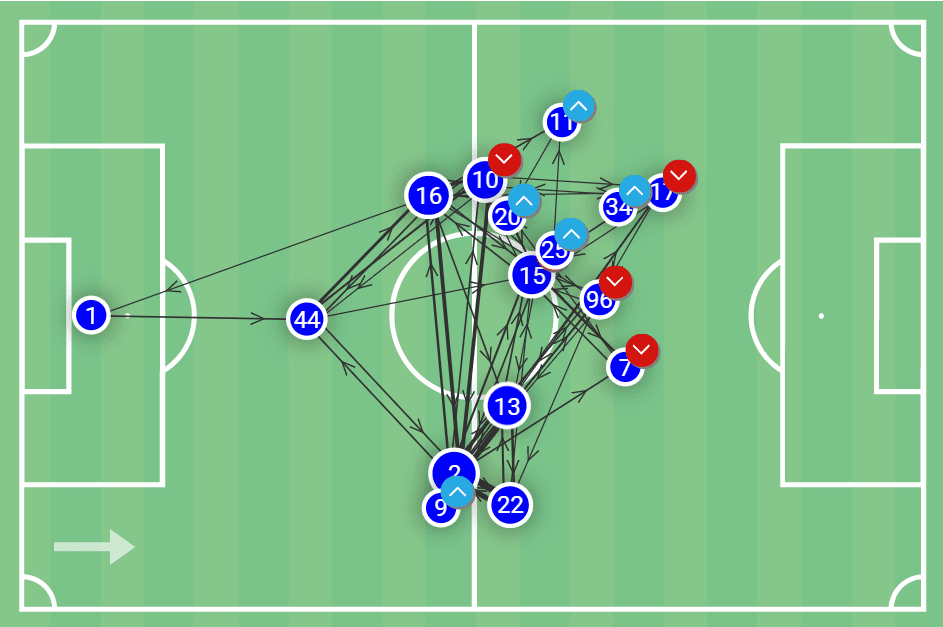
As their struggles in 2022 continued, Vojvoda decided to make drastic changes in Fortaleza’s tactics, and this began with their structure. In 2021, the back three were key to how they structured in and out of possession. Looking to revive his side, Vojvoda switched to a back four. Although Vojvoda began experimenting with this earlier, it only became definite after Yago Pikachu’s departure to Japan. The right wing-back was a key piece to how they played and without his attacking support, Vojvoda decided to complete the switch to a back four.
This season, their formation distribution looked much different. The 3-4-1-2 is still there, as they began the season with it, but it dropped to only 23%. Between the 4-4-2 and the 4-2-3-1, Vojvoda used a back four 27% of the time, with the rest being a number of other variations. After the transfer window closed, their shift to a back four was complete and has been their structure ever since.
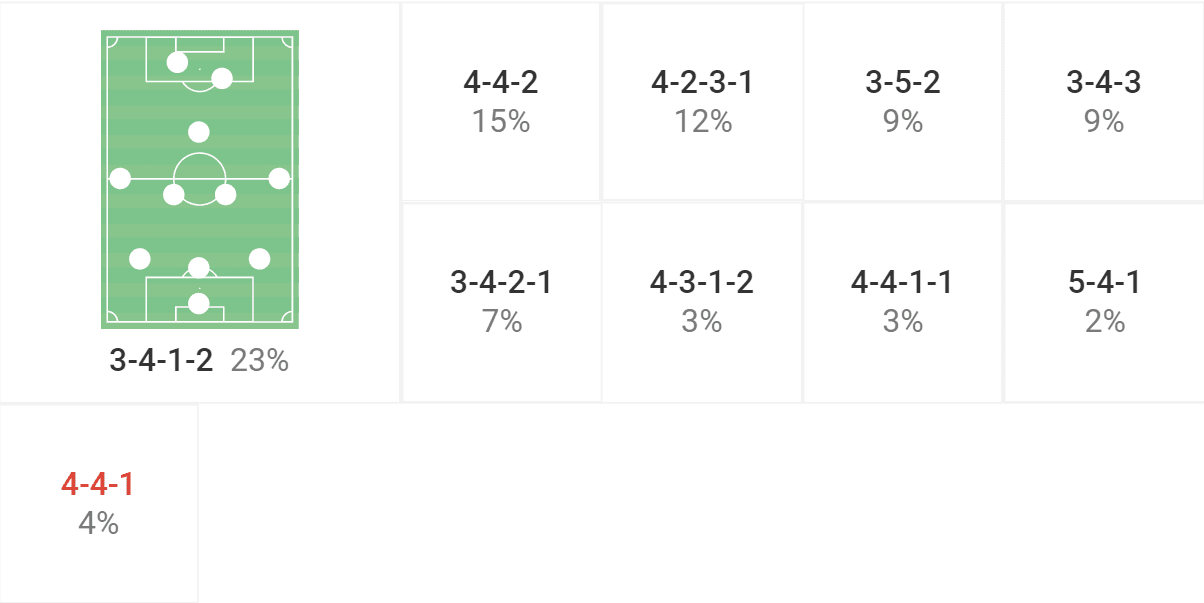
After such a drastic change in structure, Marcelo Paz stepped in to help Vojvoda. The club president signed six new faces, with most of them diving straight into the starting eleven. These signings have provided a refreshing look to Fortaleza and helped Vojvoda transition into his new tactics.
The 4-2-3-1 and the 4-4-2 are essentially the same structure, with the only distinction being how forward the number 10 gets. Instead of joining the wide players, the double pivot is now the heart of the side. It is composed of new signings Lucas Sasha and Caio Alexandre, who are able to play a significant role in and out of possession. Ahead of them, the front four is quite fluid and dynamic.
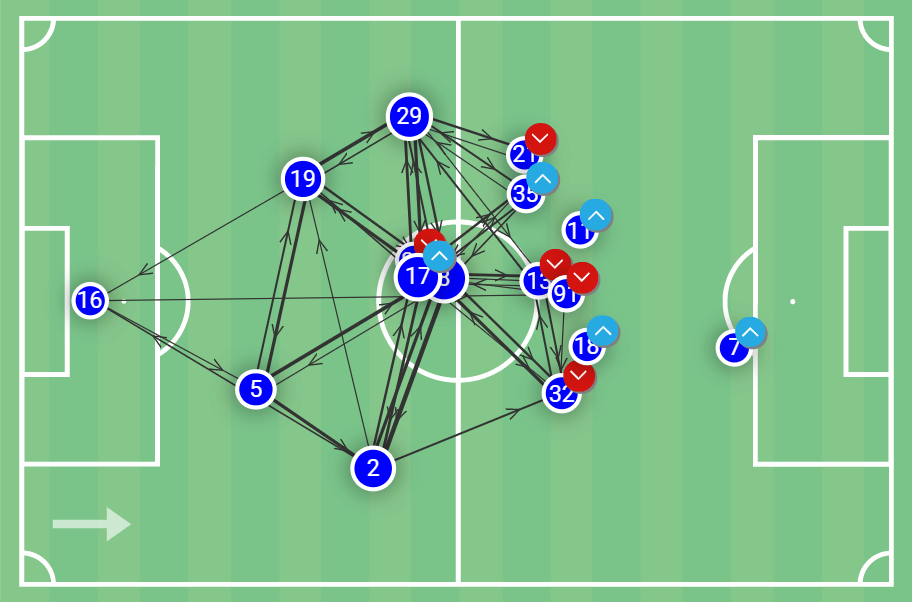
New attacking approach
With his new structure, Vojvoda has introduced a brand new attacking approach. Their possession average dropped from 50.6% in 2021 to 45.25% in 2022. Similarly, they average 38.49 fewer passes per 90. Nonetheless, they still average around the same 125 forward passes per 90, 41 long passes per 90, and 65 progressive passes per 90. This trend towards a slightly more direct approach is confirmed by their long pass percentage, which also increased. Although they have slightly changed their behaviour with the ball, the real change was in their structure.
To begin with, as mentioned, they shifted to a back four. Last year, Fortaleza began their build-up with a back three and wide overloads. This is no longer the case, as initially, the double pivot remains quite central and connected.
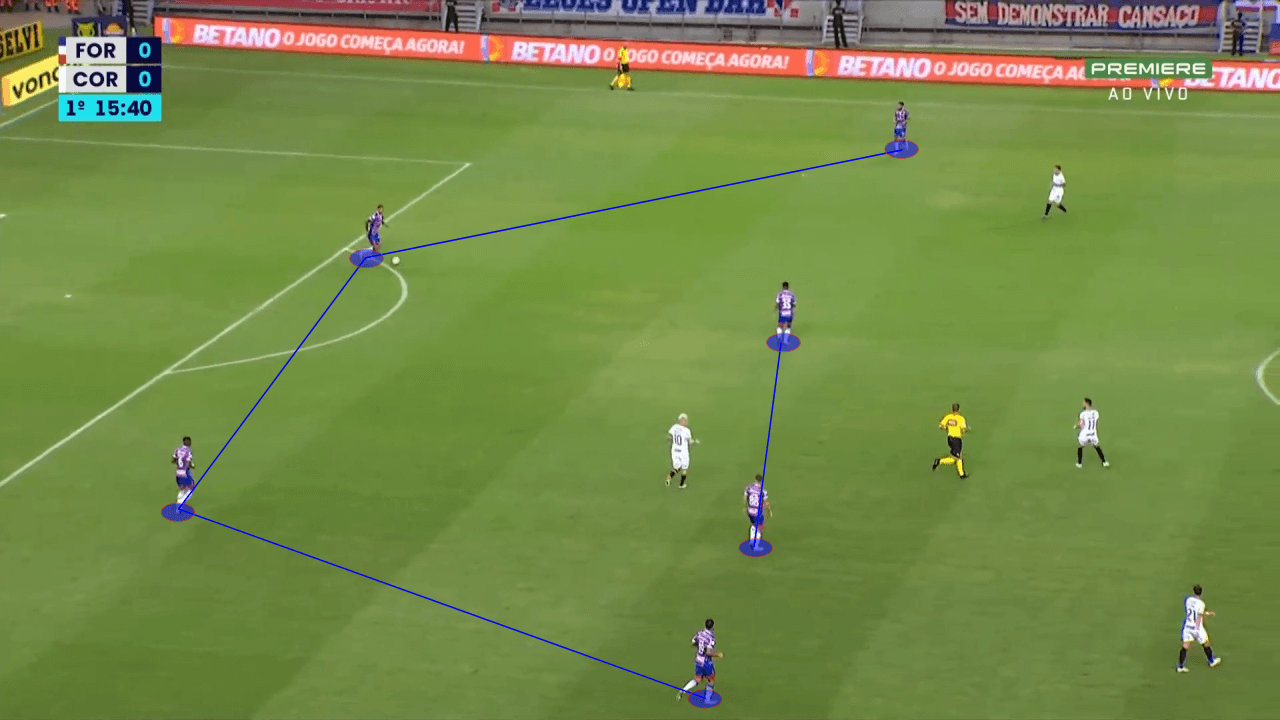
Although that is their initial structure, they quickly began numerous positional rotations to disorganise and manipulate the opposition’s defensive structure. The most constant one is either fullback pushing up while the nearest central midfielder drifts wide. This movement, as highlighted below, leaves space in the midfield for further rotations to happen.
At this point, Fortaleza react to what the opposition gives them. If the midfielder is not followed wide, they are able to create numerical superiority and progress through the wide areas. If he is, space is left in the middle.
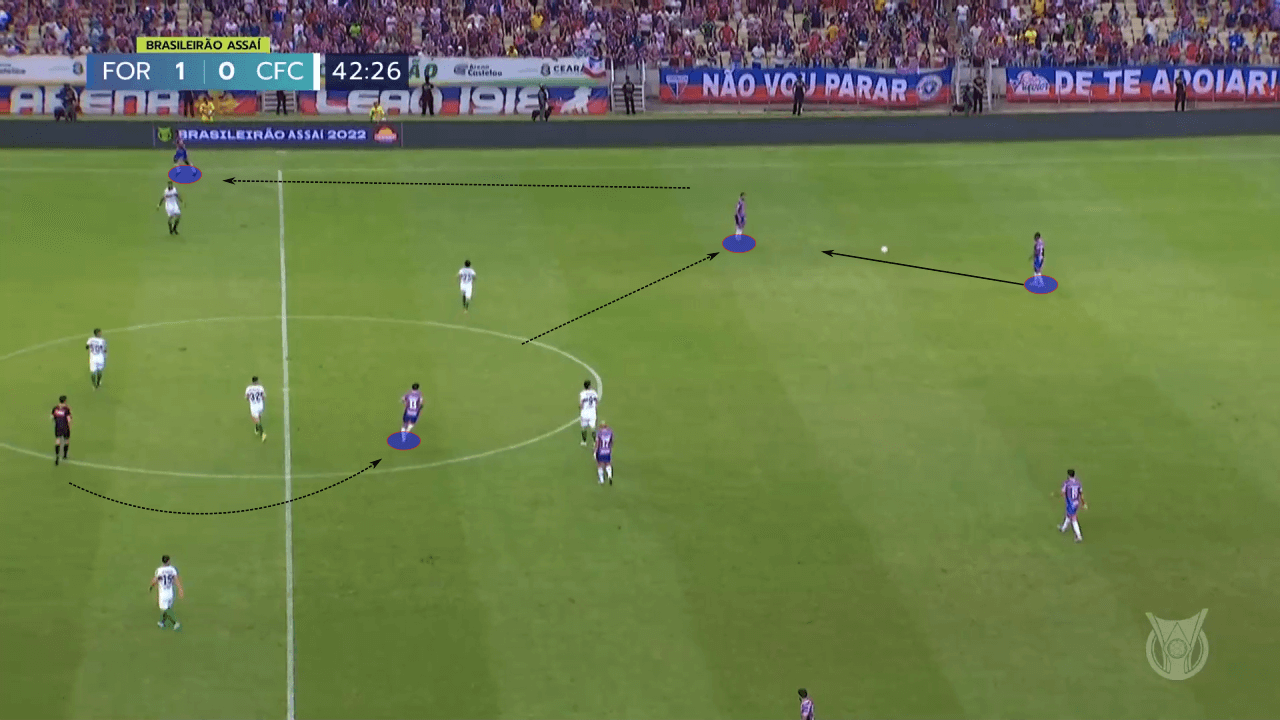
When this space is left in the middle, it can be attacked by numerous advanced players. In the instance below, while the left-back remains wide, the left-winger, attacking midfielder, and opposite centre-midfielder all come over to provide options. This new rotational and fluid approach has seen them become much more dynamic, being able to create either centrally or out wide.
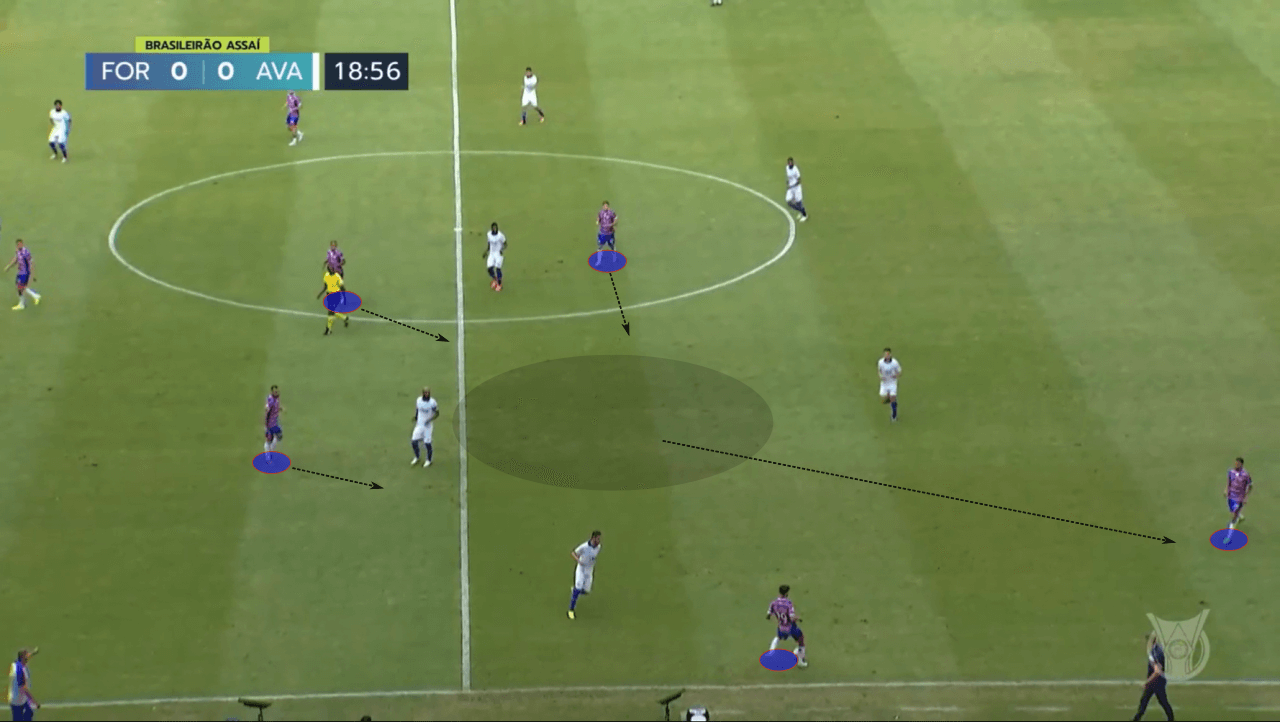
These positional rotations can be performed by anyone, as long as balance is kept. Vojvoda always asks for his players to maintain maximum width, with at least one player on each wing channel. In the midfield, the rotations are more free-flowing. This can be further illustrated in the image below.
As the left-back, Juninho Capixaba, drifts into the midfield, the winger drops to maintain the width. With his movement, Capixaba confuses Avaí’s marking and creates an opportunity for Rómulo Otero to receive the ball between defensive lines. The channel through which Otero received is only possible because of the winger’s width, which kept Avaí’s defensive line stretched.
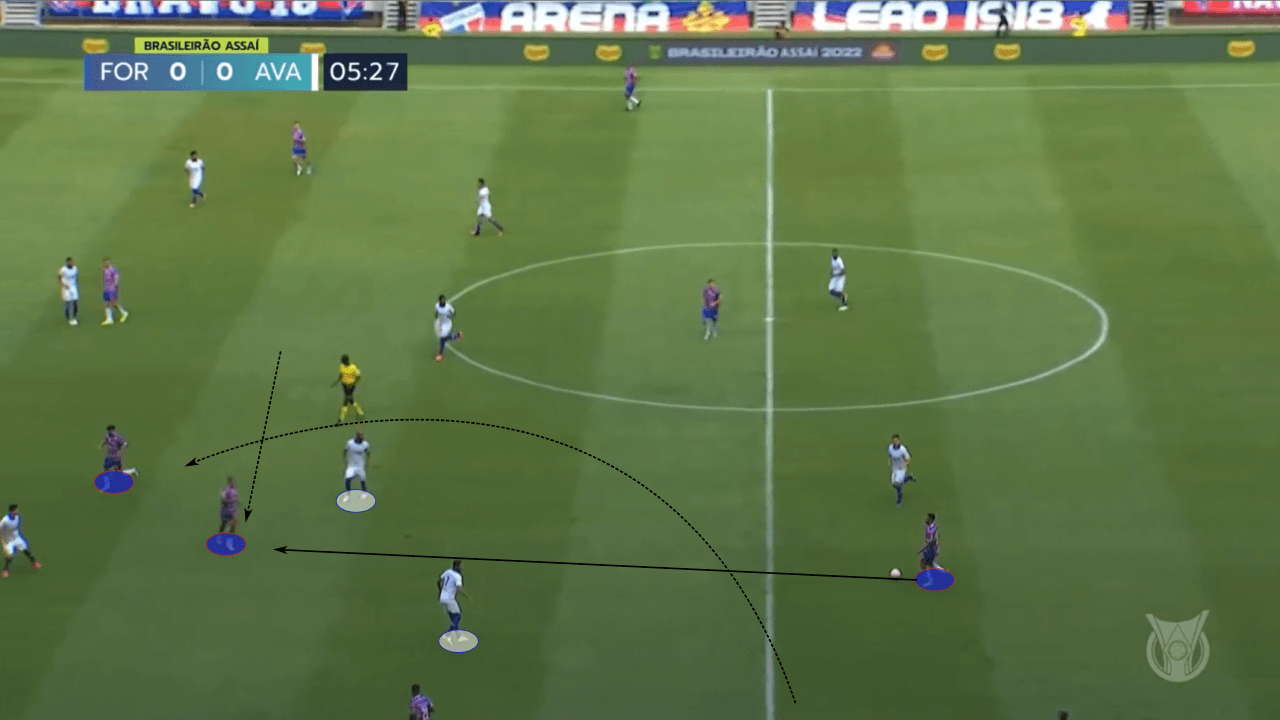
In fact, Capixaba’s role as the left-back has been crucial to their revival. With his movement, the left-back is constantly able to create space and help Fortaleza progress forward. In another example below, he drifts inside once again while the winger drops to his previous position.
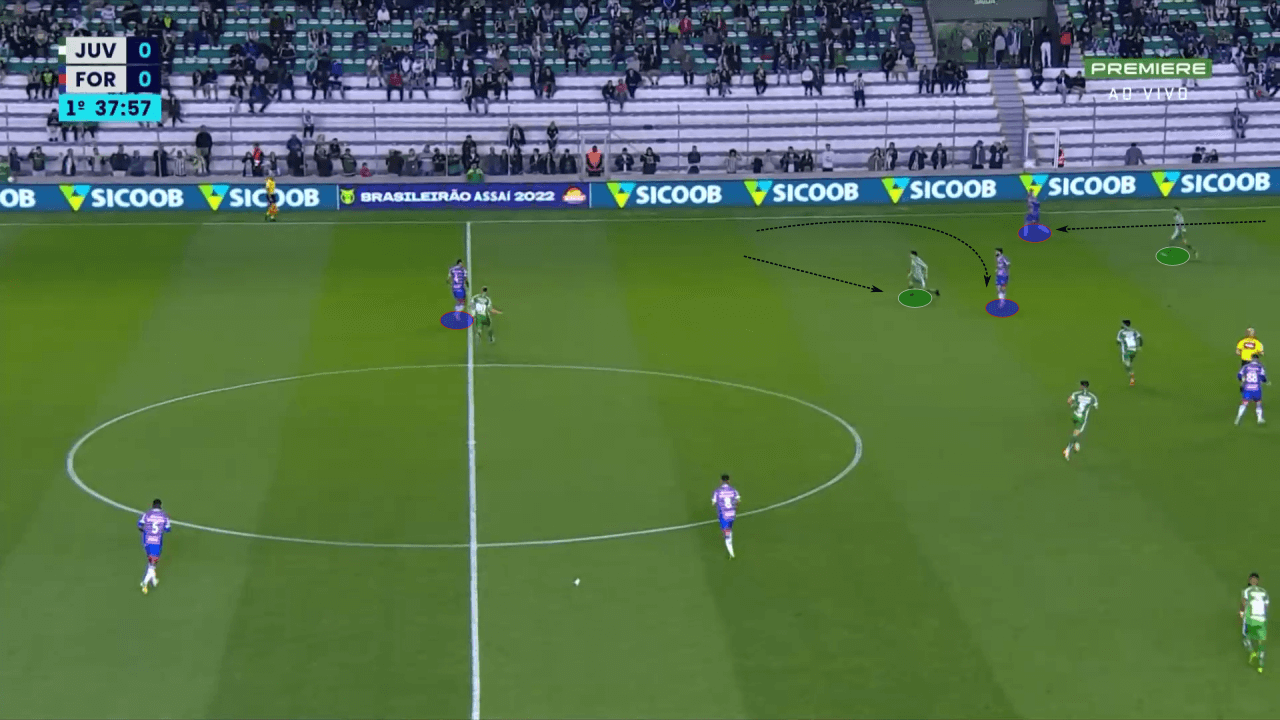
Capixaba advances further inside, and after Thiago Galhardo, the centre-forward, checks in and drags the centre-back with him, Capixaba attacks the space left behind. In Fortaleza’s new attacking approach, there is constant and coordinated movement everywhere.
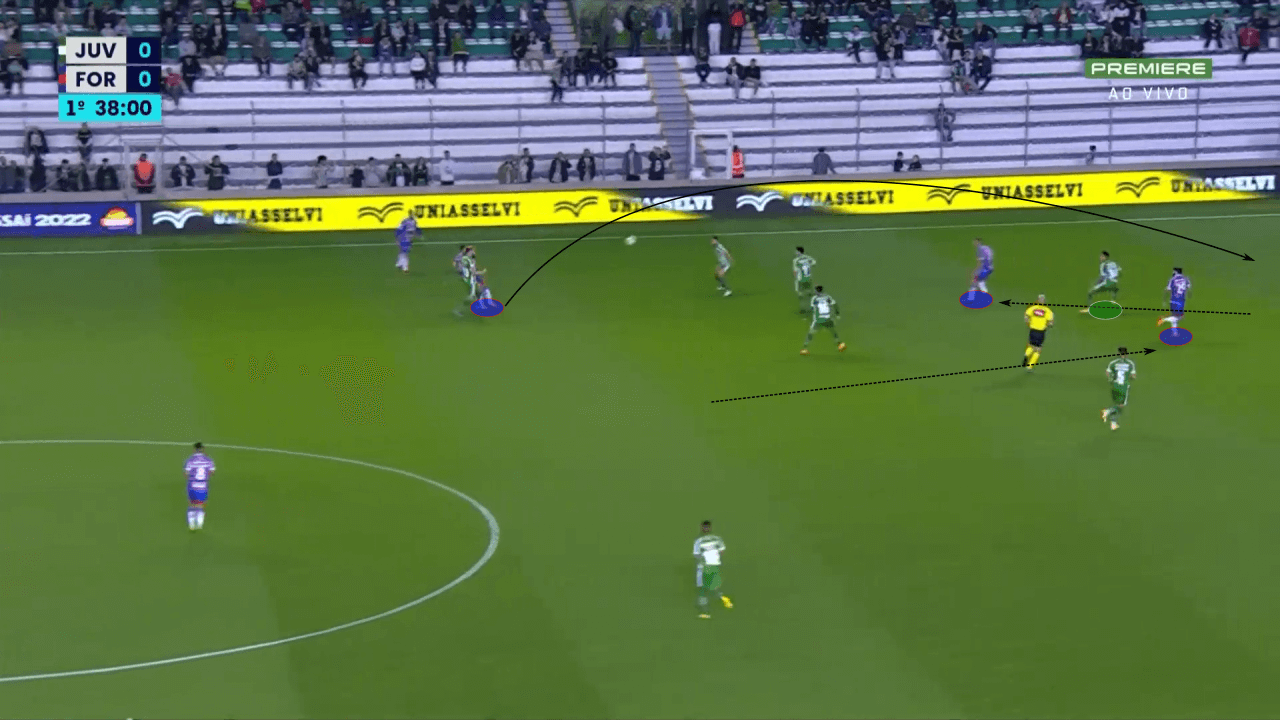
Constantly maintaining depth and width is also key to Fortaleza’s new attacking approach. Vojvoda wants his side to stretch the opposition’s defensive organisation and create space and lanes for his team to play through.
In the instance below, Fortaleza maintain maximum width as they look to progress into the final third. With the winger pinning the opposition’s left-back wide, a channel is created between the fullback and the centre-back. Sasha is able to attack this space and receive it in the final third.
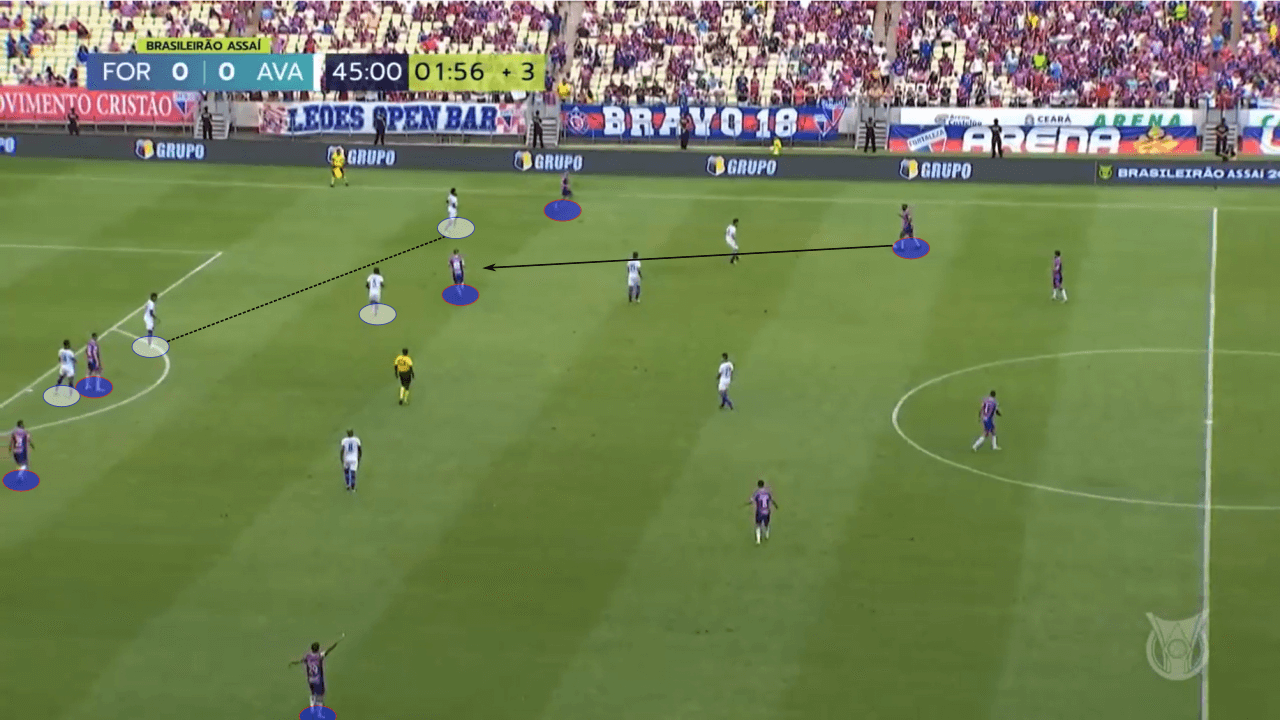
Depth is also important. Fortaleza’s front four are constantly looking to attack the space behind the opposition’s defensive line. While these runs in behind offer long passing options, they also disorganise the backline and force them to drop further. Against Goiás, they find success playing a long ball over the opposition’s mid-block.
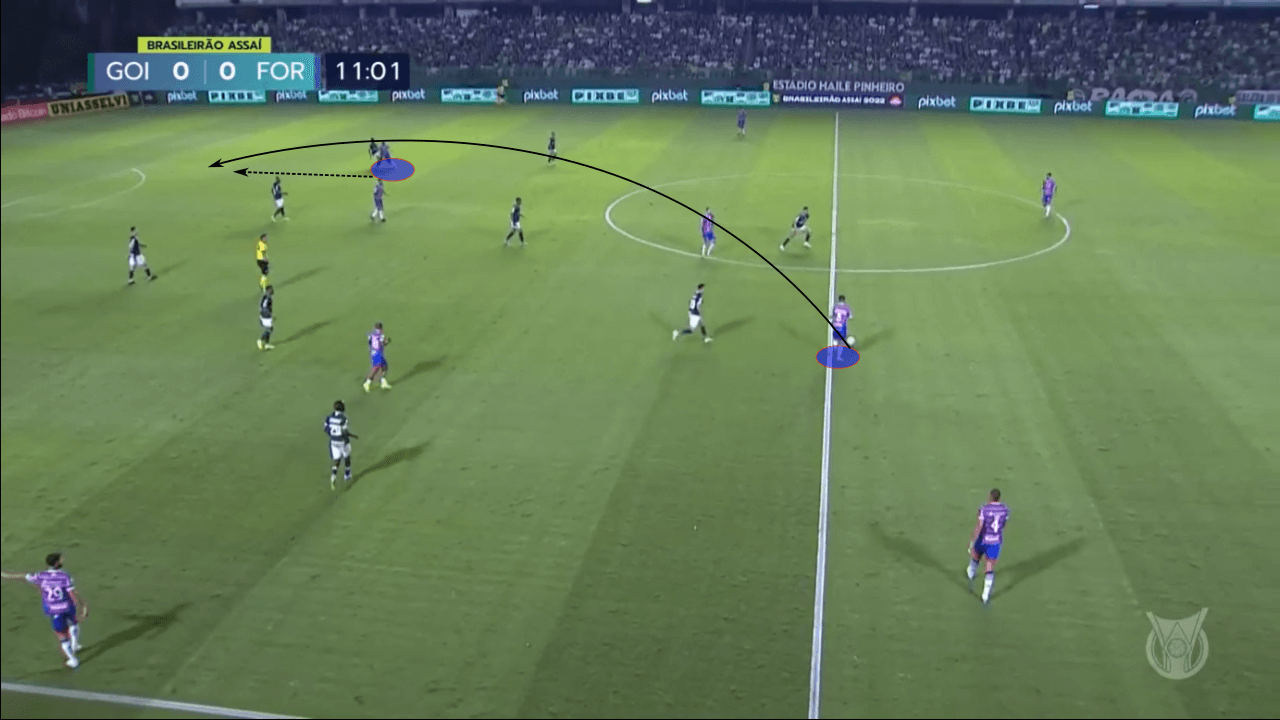
Restoring defensive security
A lack of defensive security was at the heart of their struggles early on this season. Similar to his biggest influence Marcelo Bielsa, Vojvoda assembled a relentless and intense defensive system in Fortaleza. Last year, without the ball, they looked to maintain their 3-4-1-2 structure as they pressed high and aggressively. They averaged a PPDA of 9.9 throughout the season, often being able to cause danger from their high press.
This year, however, they struggled to find similar success. They were easily played through, without much cohesion in the pressing structure. As with the attacking phase, Vojvoda found the answers by completely restructuring them defensively. Now with a 4-4-2, they have also slightly changed their defensive behaviour.
Looking set to finish the season with a PPDA around 11, they are not pressing as high as they used to. The intensity is still there, but it begins once their mid-block is penetrated. Of course, there are many triggers which see them advance into a high block. However, an initial mid-block has helped them restore defensive security.
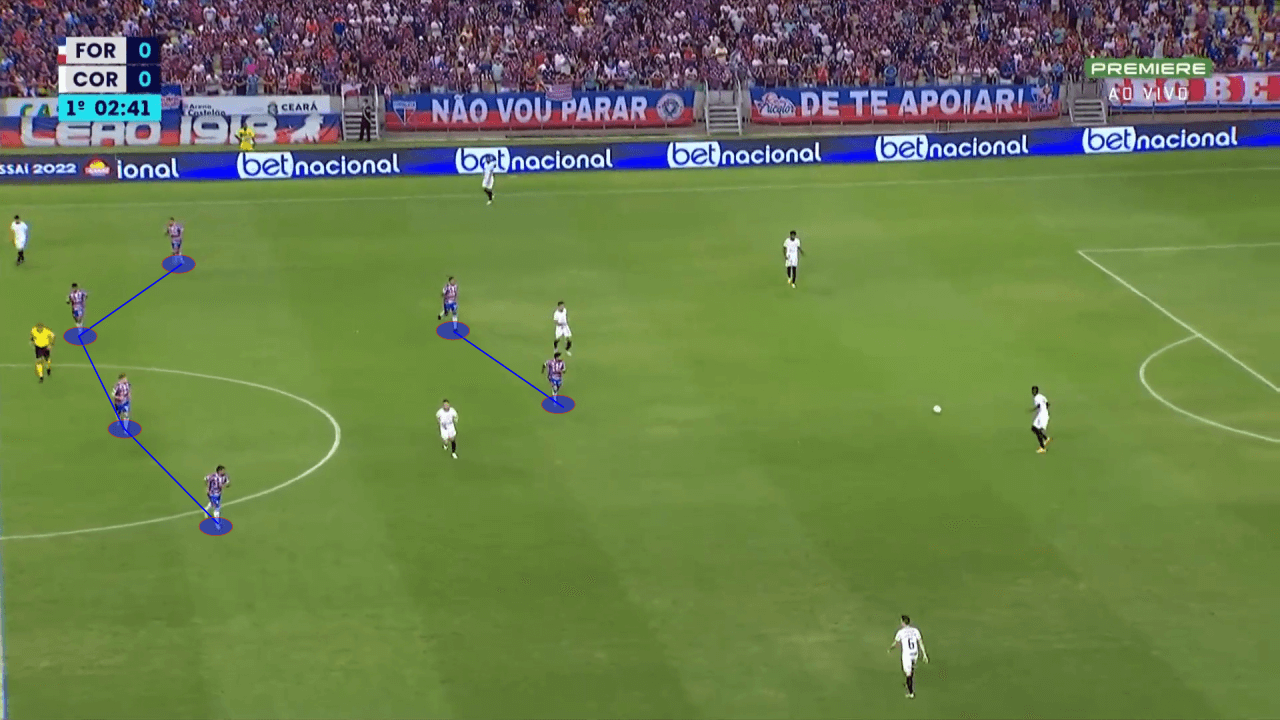
When they advance their block, coordination is essential. Rather than maintaining a set shape, they will adopt man-references which can easily change depending on where the ball is. Therefore, coordination when shifting their marking is crucial.
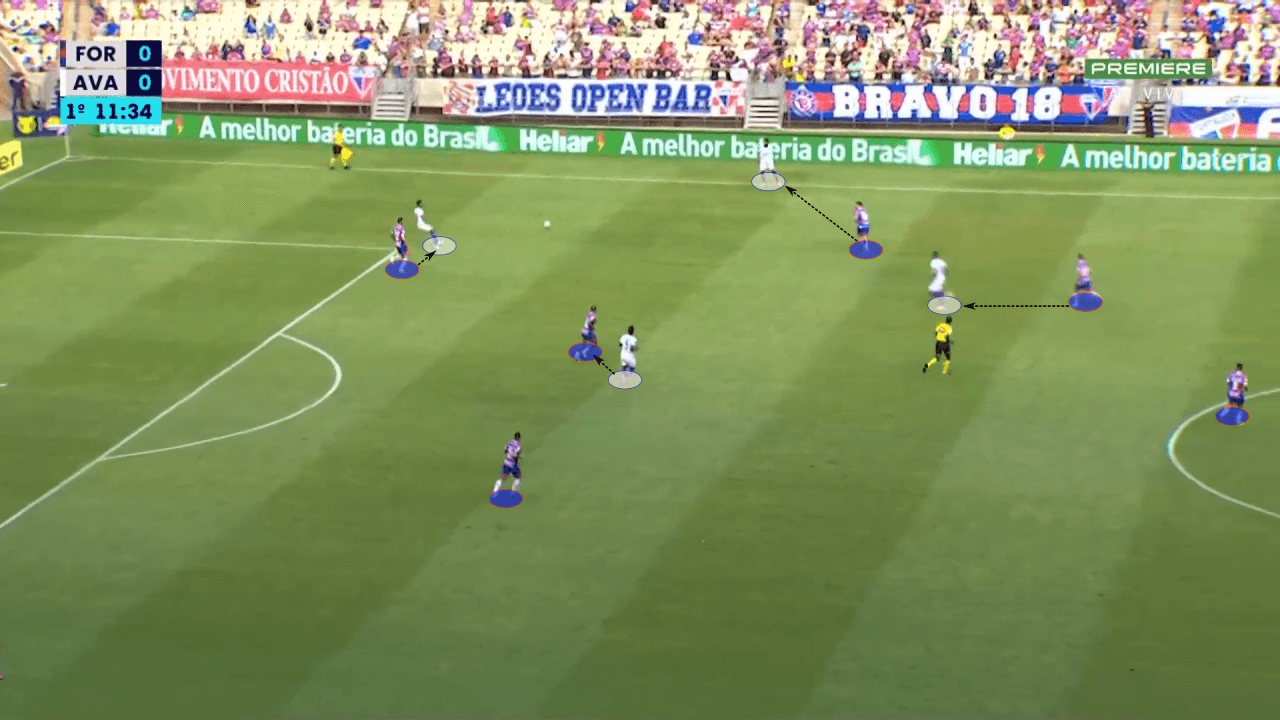
Regardless of the height of the defensive block, Vojvoda’s men are constantly tracking runners. Despite structuring in a compact 4-4-2, they are constantly tracking runners and closing down passing options. This can be seen in the example below as Corinthians look to progress through the left side. As Fortaleza’s block shifts over, they adopt man-references looking to eliminate Lucas Piton’s passing options.
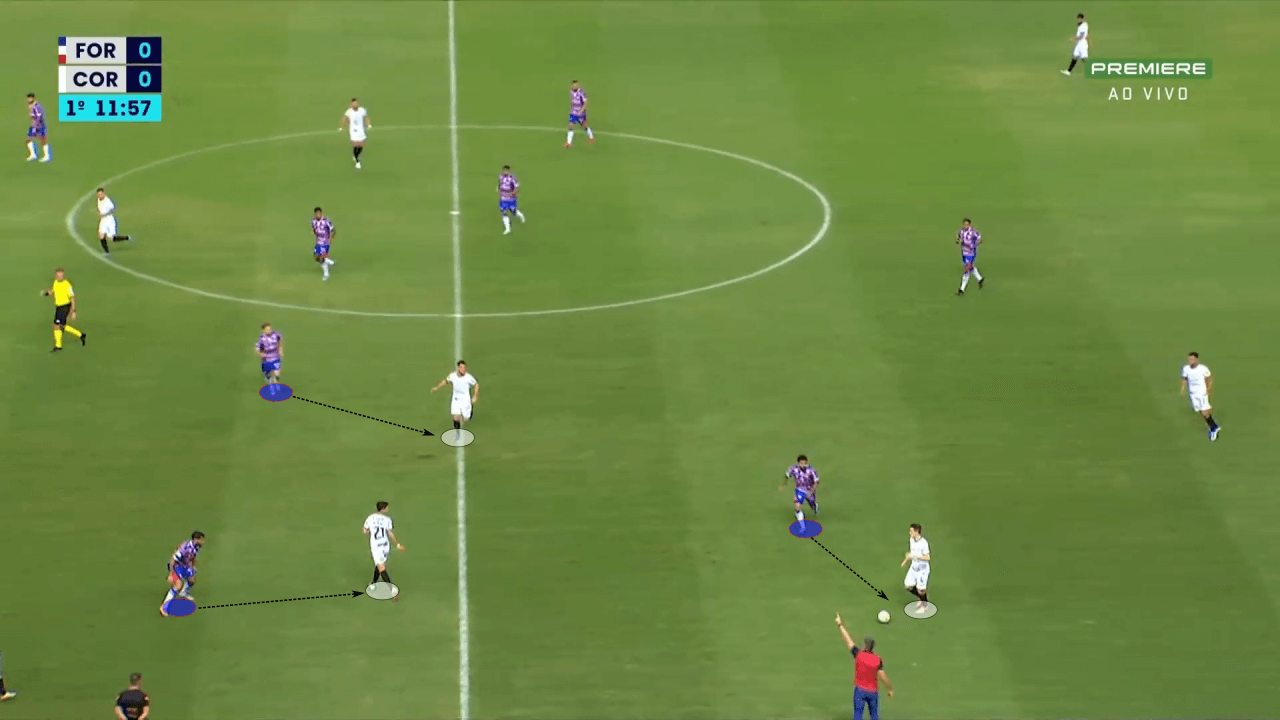
The main reason a mid-block was able to restore defensive security was its compactness. Once the opposition penetrates their mid-block, they are able to throw a lot of numbers at the ball and overwhelm the opposition. By remaining compact, they are constantly able to find superiority around the ball and consequently, security.
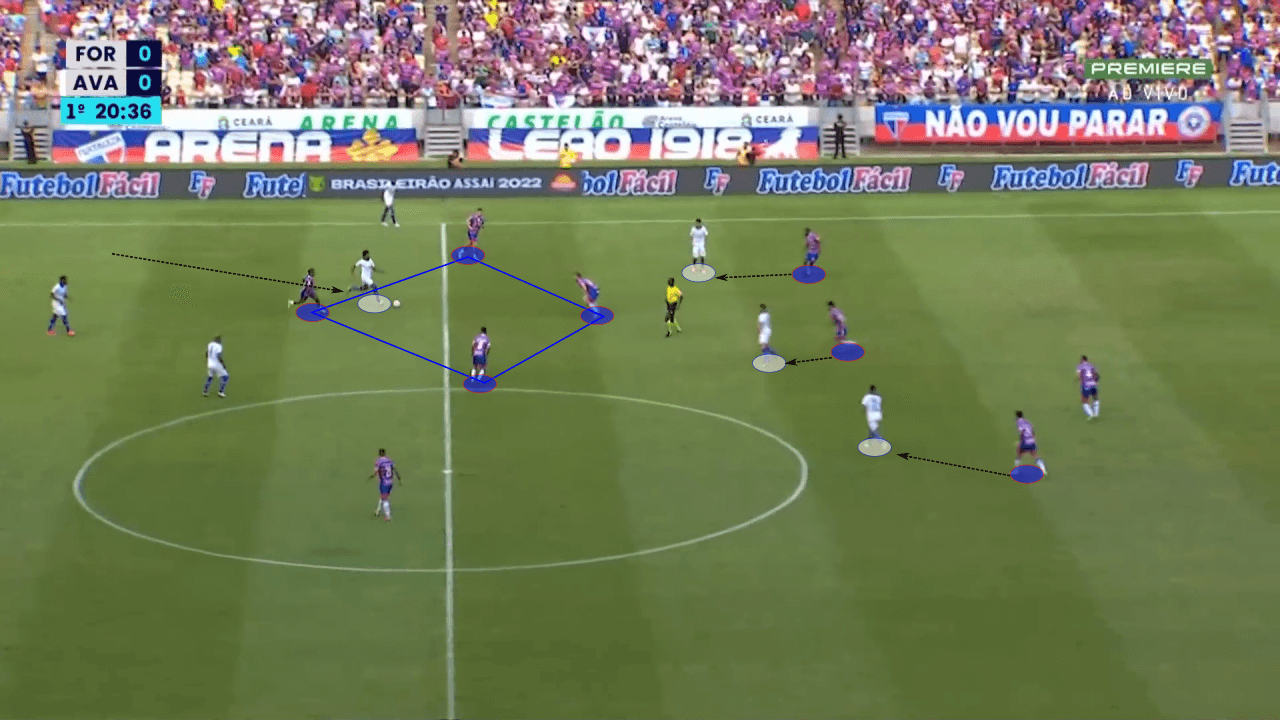
The 4-4-2 has been another reason behind their new defensive success. This formation is perhaps the most common defensively, as it provides extreme balance and compactness on all levels, especially in wide areas.
For instance, below as Flamengo try to create wide, Fortaleza are quickly able to create a 4v3 superiority and keep them from progressing. With the right-back advancing forward, the centre-midfielder pushing up, and the centre-forward shifting over, they are able to gain numbers and eliminate passing options.
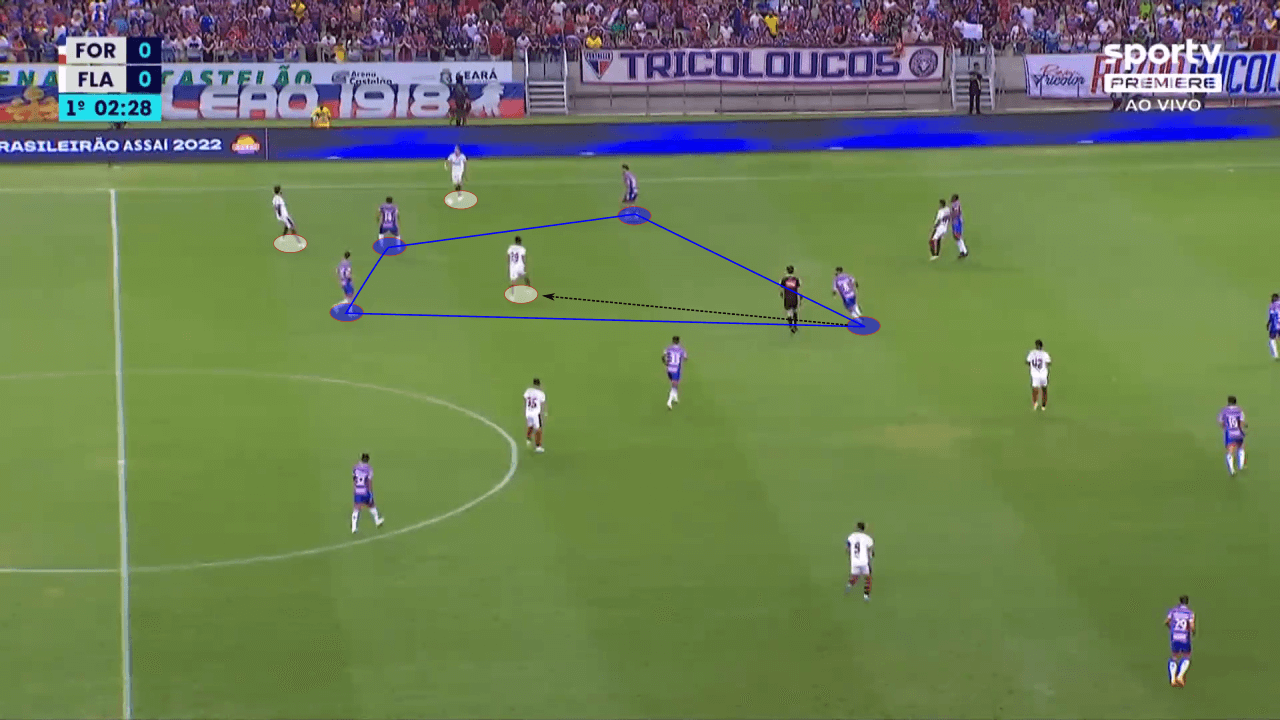
This superiority is also able to be found in lower blocks. As seen against América Mineiro below, they are able to shift four players across and keep the opposition from playing into the central channels. The 4-4-2, with its balanced and compact structure, has seen Vojvoda restore defensive security by constantly having numbers around the ball and keeping the opposition from advancing.
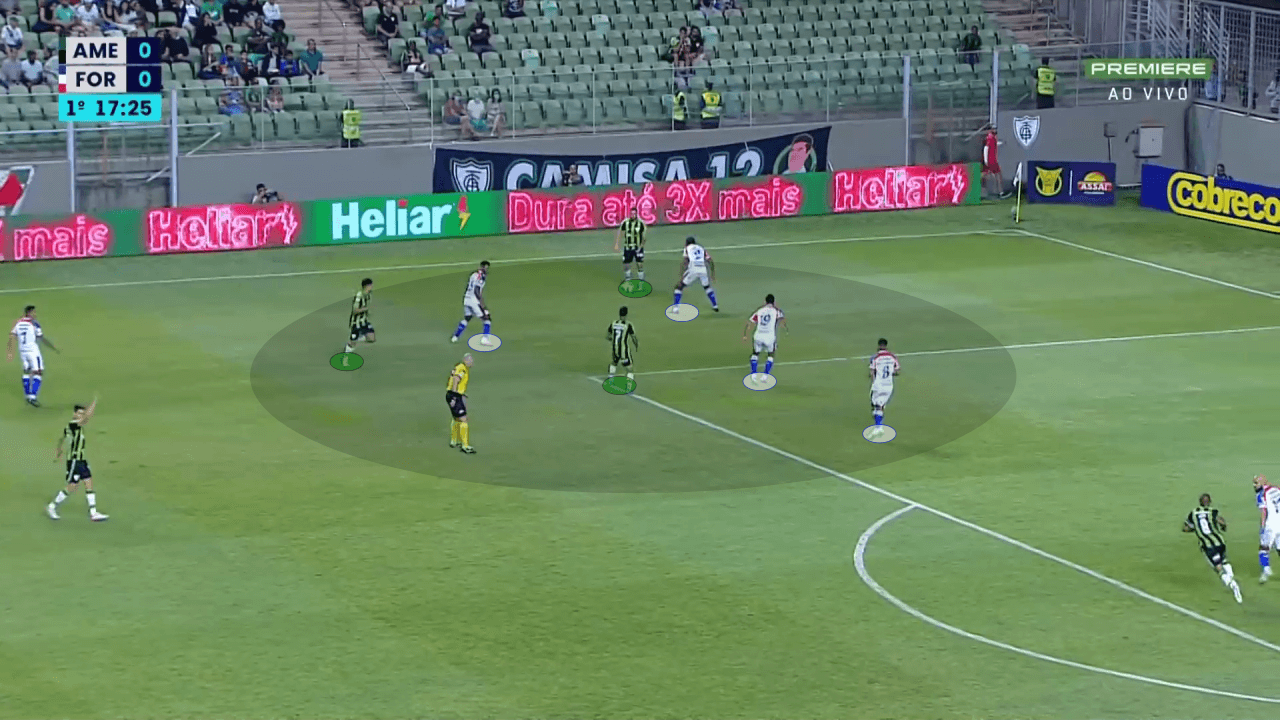
It is also able to provide extreme compactness when they revert to low blocks. While the centre-forwards remain high as outlets, the two lines of four are able to remain compact and low. In the image below, as América try to enter Fortaleza’s box, they are met with a staggering eight-man block.
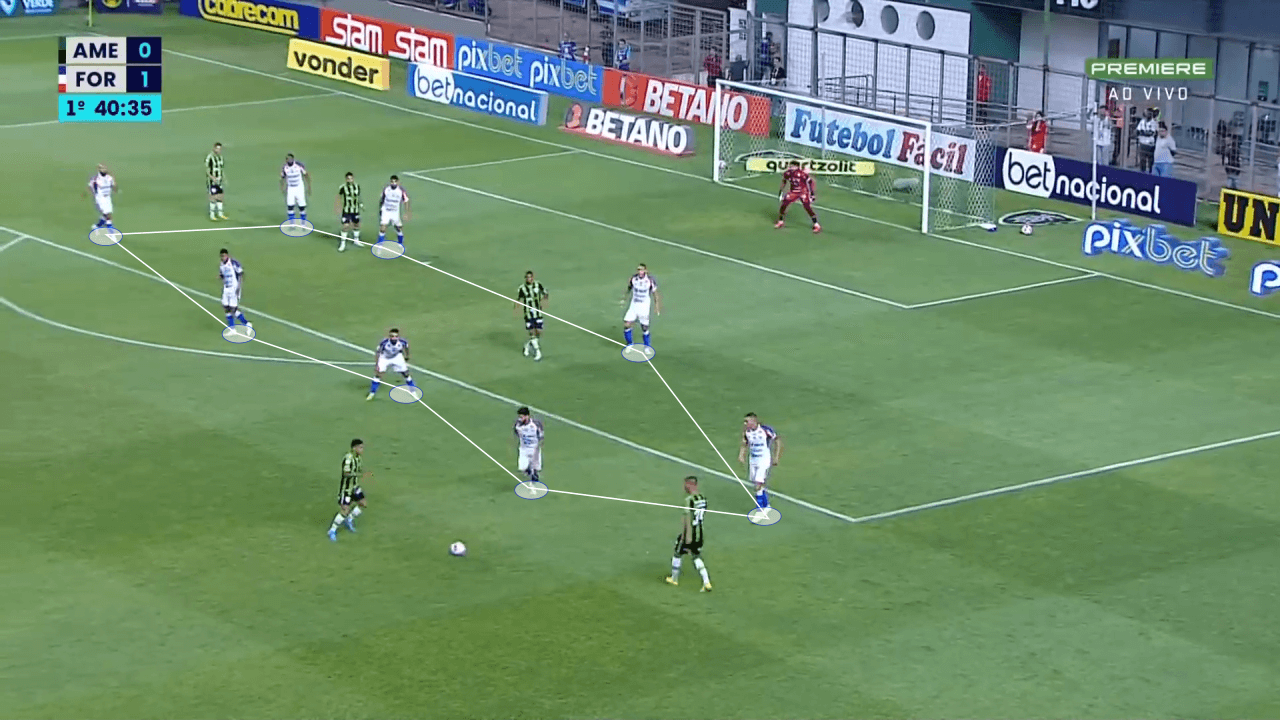
Conclusion
After a difficult start to the 2022 season, Juan Pablo Vojvoda had to reinvent himself. With his highly-praised tactics from 2021 no longer proving effective, the Argentinian manager decided to completely restructure Fortaleza in and out of possession. Such change was met with support from the president, who brought in six new faces.
This new-look Fortaleza have been able to climb to a comfortable mid-table finish, where relegation is far from a problem. In the 2023 season, Vojvoda will be able to start from scratch and dream with another Libertadores qualification. That is, of course, if he doesn’t get snapped up by one of the big clubs.





Comments